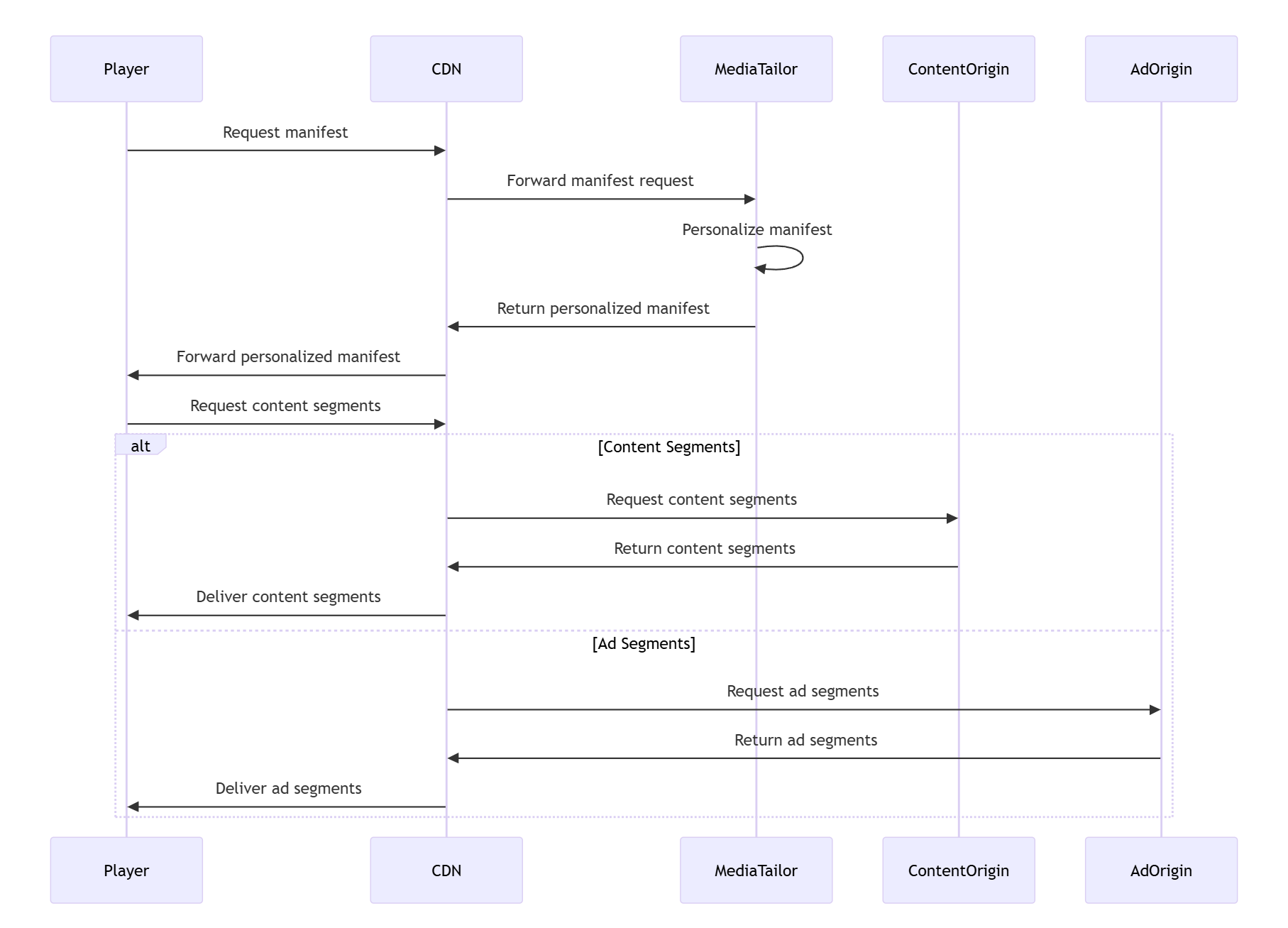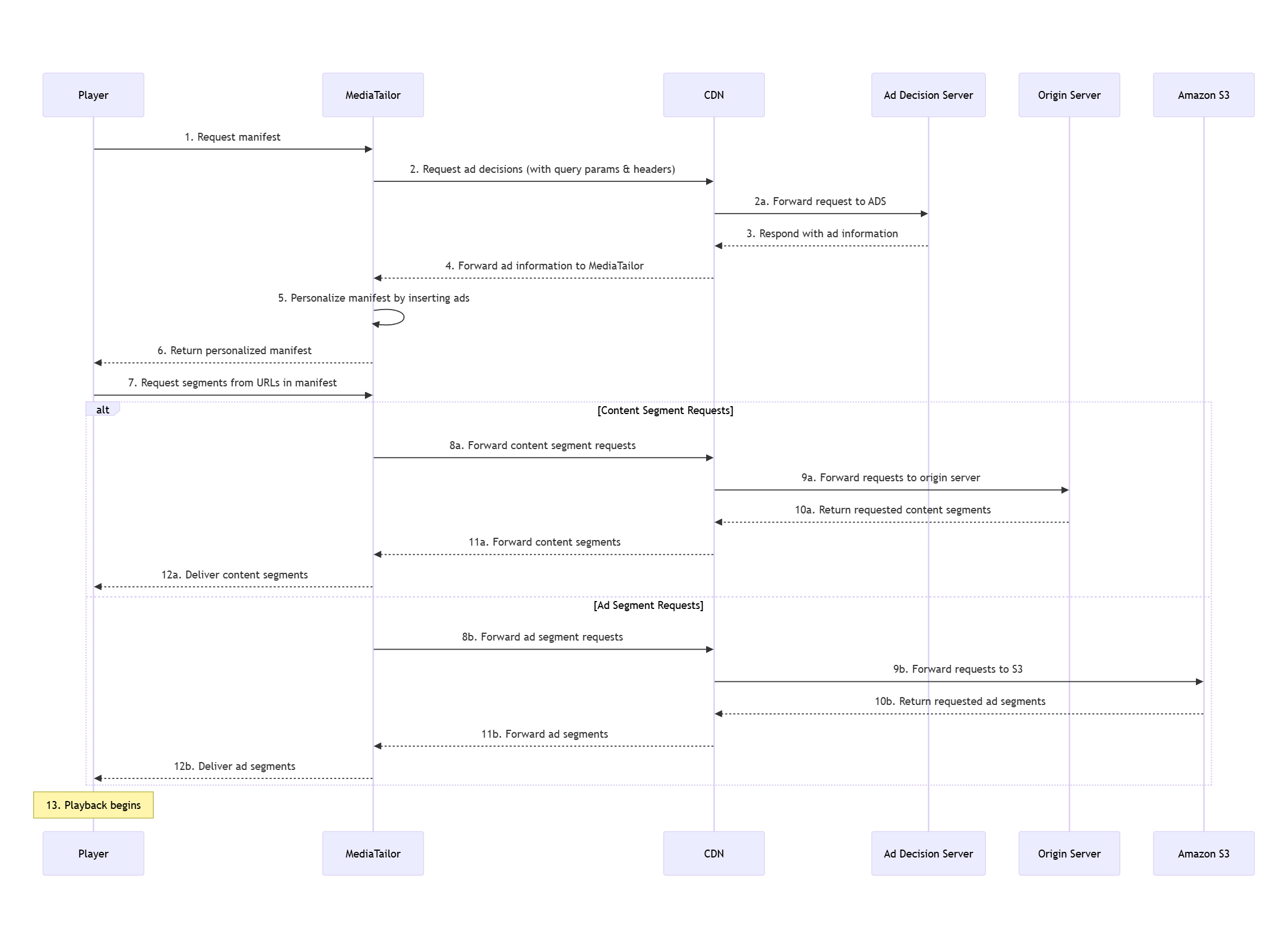Las traducciones son generadas a través de traducción automática. En caso de conflicto entre la traducción y la version original de inglés, prevalecerá la version en inglés.
Comprenda la arquitectura de inserción de anuncios para las CDN y las integraciones MediaTailor
En esta sección se explican los conceptos y la arquitectura de la inserción de anuncios en el lado del servidor (SSAI) con redes de entrega de contenido (CDNs) para. AWS Elemental MediaTailor Aprenderás cómo la inserción dinámica de anuncios y la manipulación de los manifiestos funcionan de forma conjunta para conseguir una monetización eficaz de los vídeos.
La inserción de anuncios en el servidor (SSAI) te permite: MediaTailor
-
Inserta publicidad personalizada en tus transmisiones de vídeo en puntos de interrupción de anuncios definidos
-
Segmenta los anuncios con precisión en función de los datos de los espectadores
-
Elimine la necesidad de utilizar una tecnología de inserción de anuncios en el lado del cliente
Si se combina con una CDN, puede ofrecer estas transmisiones personalizadas a los espectadores con un rendimiento y una escalabilidad mejorados, lo que mejora su estrategia de monetización de vídeos.
La arquitectura recomendada para la inserción de anuncios con una CDN sitúa a la CDN entre los espectadores y la inserción de anuncios, ya que la inserción de anuncios permite acceder al contenido directamente desde su origen. Esta arquitectura ofrece las siguientes ventajas tanto para la entrega de contenido como para la monetización de los vídeos:
-
Almacenamiento en caché eficaz del contenido y los segmentos de anuncios
-
Se ha reducido la carga de solicitudes en MediaTailor
-
Velocidad de entrega mejorada a los espectadores
-
Administración de URL simplificada
-
Entrega uniforme de publicidad personalizada en todos los dispositivos
En esta arquitectura recomendada:
-
Los espectadores solicitan manifiestos a la CDN
-
La CDN reenvía las solicitudes para la inserción de anuncios
-
La inserción de anuncios solicita los manifiestos de contenido desde el origen
-
La inserción de anuncios solicita anuncios del servidor de decisiones publicitarias (ADS)
-
La inserción de anuncios personaliza los manifiestos sustituyendo los marcadores de anuncios (del manifiesto de origen) por los URLs que apuntan a segmentos de anuncios segmentados para un espectador específico (del ADS)
-
La inserción de anuncios devuelve los manifiestos personalizados que contienen un segmento de anuncios URLs a la CDN, que los reenvía a los espectadores
-
Los espectadores solicitan segmentos a través de la CDN
-
La CDN enruta las solicitudes de segmentos en función del tipo de segmento:
-
Las solicitudes de segmentos de contenido van al origen del contenido
-
Las solicitudes de segmentos de anuncios van a MediaTailor
-
Esta arquitectura garantiza un rendimiento óptimo y, al mismo tiempo, mantiene los beneficios de seguridad y flexibilidad del uso de una CDN.

nota
Este flujo varía ligeramente entre el VOD y el contenido en directo. En el caso del VOD, los manifiestos se pueden almacenar en caché durante más tiempo, mientras que el contenido en directo requiere actualizaciones de los manifiestos más frecuentes para mantener la continuidad de la transmisión.
La diferencia clave entre el almacenamiento en caché de contenido en directo y VOD es la siguiente:
- Contenido VOD
-
Establezca valores TTL más largos (minutos u horas) para los manifiestos porque no cambian con frecuencia
- Contenido en directo
-
Establezca valores de TTL más cortos (segundos) para los manifiestos para garantizar que los espectadores reciban los segmentos de transmisión más actuales
No te recomendamos que coloques una CDN entre el origen del contenido y. AWS Elemental MediaTailor Hacerlo puede suponer varios desafíos técnicos:
- Colisiones entre claves de caché
-
Configure su CDN para que gestione correctamente los parámetros de consulta. Esto MediaTailor evita que se reciban manifiestos incorrectos al solicitar el mismo manifiesto con parámetros de consulta diferentes.
- Problemas de compresión de Gzip
-
Si experimentas errores al analizar los manifiestos, asegúrate de que tu CDN entregue los manifiestos con el formato correcto a. MediaTailor Algunos CDNs pueden incluir cargas gzip corruptas que pueden provocar errores de análisis. Si esto ocurre, es posible que tengas que deshabilitar la compresión entre tu CDN y, al MediaTailor mismo tiempo, mantenerla para ahorrar costes en otros aspectos del flujo de trabajo.
- Frescura manifiesta
-
Para las transmisiones en directo, configura tu CDN para que entregue los manifiestos actuales a MediaTailor. Esto evita problemas de sincronización entre el contenido y los anuncios.
- Optimización del rendimiento
-
Minimice los saltos de red y las posibles pérdidas de memoria caché para reducir los tiempos de inicio de la reproducción.
- Administración de la memoria caché
-
Implemente estrategias simplificadas de invalidación de la caché, especialmente para el contenido en directo en el que los manifiestos se actualizan con frecuencia.
En esta arquitectura subóptima:
-
Los espectadores solicitan listas de reproducción multivariantes, listas de reproducción multimedia o MPDs directamente de. AWS Elemental MediaTailor
-
MediaTailor solicita manifiestos de contenido (listas de reproducción multivariantes, listas de reproducción multimedia o MPDs) a través de la CDN.
-
La CDN reenvía las solicitudes al servidor de origen.
-
El servidor de origen devuelve listas de reproducción multivariantes, listas de reproducción multimedia o MPDs a la CDN.
-
La CDN reenvía listas de reproducción multivariantes, listas de reproducción multimedia o a. MPDs MediaTailor
-
MediaTailor solicita anuncios al servidor de decisiones publicitarias (ADS).
-
MediaTailor personaliza los manifiestos insertando anuncios en listas de reproducción multivariantes, listas de reproducción multimedia o MPDs los entrega directamente a los espectadores.
-
Esta arquitectura introduce una latencia adicional, posibles problemas de almacenamiento en caché y complica la solución de problemas.

Flujo de solicitudes y respuestas
Al implementar la inserción dinámica de anuncios con una CDN, configura tu sistema para que admita este flujo de solicitudes y respuestas:
-
Configura tu reproductor para que solicite listas de reproducción multivariantes (HLS) o MPDs (DASH) desde tu CDN que tengan como origen el manifiesto. MediaTailor
-
Configura tu CDN para que reenvíe todas las solicitudes de listas de reproducción multivariantes, listas de reproducción multimedia y MPD, incluidos todos los parámetros y encabezados de consulta. MediaTailor
-
Asegúrate de MediaTailor poder comunicarte con tu servidor de decisiones publicitarias (ADS) y transmitir los parámetros y encabezados de las consultas.
-
Configure su ADS para que utilice los parámetros de consulta para determinar qué anuncios debe insertar.
-
Configura el prefijo de la CDN en la configuración de MediaTailor reproducción para MediaTailor poder sustituir los prefijos de URL de contenido y segmento de anuncios por nombres de dominio de la CDN.
-
Configura tu CDN para que reenvíe listas de reproducción multivariantes personalizadas, listas de reproducción multimedia y desde al reproductor solicitante. MPDs MediaTailor
-
Configura tu CDN para traducir el segmento URLs y reenviar las solicitudes de segmentos de contenido al servidor de origen y las solicitudes de anuncios al depósito de Amazon S3, donde se MediaTailor almacenan los anuncios transcodificados.
Terminología de CDN para la inserción de anuncios
Entender estos términos clave te ayudará a implementar y solucionar los problemas de tu integración con la CDN de inserción de anuncios:
- CDN de origen y CDN perimetral
-
CDN de origen: una CDN situada entre el origen MediaTailor y el origen del contenido. Almacena en caché los segmentos de contenido para reducir la carga en los servidores de origen. En una arquitectura de múltiples CDN, esta es la primera capa de CDN que interactúa directamente con el origen.
Edge CDN: una CDN posicionada entre los espectadores y. MediaTailor Ofrece manifiestos y contenido personalizados a los espectadores. En una arquitectura de múltiples CDN, esta es la capa de CDN más externa que interactúa directamente con los espectadores.
- Términos de configuración de CDN
-
Comportamiento de la caché: reglas que determinan cómo gestiona una CDN los distintos tipos de solicitudes. Estas reglas incluyen:
-
Configuración de la duración del almacenamiento en caché
-
Configuraciones de enrutamiento de origen
-
Parámetros de gestión de solicitudes
TTL (tiempo de vida): el tiempo durante el cual el contenido permanece válido en la caché de una CDN antes de que sea necesario actualizarlo desde el origen.
Clave de caché: el identificador único que utiliza una CDN para almacenar y recuperar el contenido almacenado en caché. Por lo general, incluye:
-
Ruta URL
-
Parámetros de consulta
-
Encabezados seleccionados
Escudo de origen: capa de almacenamiento en caché intermedia entre las ubicaciones perimetrales de la CDN y el servidor de origen. Reduce el número de solicitudes a tu origen.
Contracción de solicitudes: función de CDN que combina varias solicitudes simultáneas del mismo contenido en una sola solicitud de origen.
-
- MediaTailor-términos específicos de CDN
-
Prefijo de segmento de contenido de la CDN: nombre de dominio de la CDN que se AWS Elemental MediaTailor utiliza al generar segmentos de contenido en URLs los manifiestos.
Prefijo de segmento de anuncios de la CDN: nombre de dominio de la CDN que se MediaTailor utiliza al generar URLs segmentos de anuncios en los manifiestos.
Para obtener más información sobre la configuración de la CDN con, consulte. MediaTailor Configure la integración de CDN
nota
Estos términos son consistentes con los que se utilizan en la documentación de ensamblaje de canales. Para obtener información sobre la terminología de ensamblaje de canales, consulteTerminología de CDN para el ensamblaje de canales.